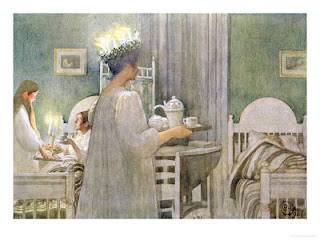
In case you missed it, December 13th was St. Lucia’s Day. Since my husband’s family is of Swedish ancestry, I made it my business to better understand their traditions. Over the years I’ve learned that Swedes are among the most stubborn (my husband says it’s tenacity – not a matter of being stubborn), hospitable (always have a pot of coffee on the stove and are ready for conversation), and have never met a stranger (my father-in-law could have gone to outer Mongolia and made friends).
If you’ve never been able to attend a Swedish St. Lucia Day festival, I highly recommend you find one next year. In Stockholm and many other places in the world – including the wonderful little town of Lindsborg, KS, St. Lucia Day celebrations are traditional Christmas season festivities.
St. Lucia was actual Italian. She lived about 283 AD and converted to Christianity during a time of pagan worship. When she refused to marry the man her deceased father had arranged for her, the groom-to-be turned her into the authorities as a Christian. She was put to death, and for years nothing much was said about her.
Legend tells that Dec. 13th-St. Lucia’s Day was eventually celebrated by Christians as a counter to the pagan celebration of the winter solstice. The tradition was said to be made official, however, when during a terrible famine in Sweden a mysterious white ship appeared on December 13th just when the people were ready to give up. There was a beautiful young woman on the bow, dressed in white with a wreath of lighted candles on her head. When the people approached the ship, they found it filled with much needed food and supplies. Of course the young woman was no where to be found, but the people were certain this had been St. Lucia bringing them a gift of food.
(This painting is by Carl Larsson, one of my favorite artists.)
Today in celebration, the eldest daughter of the family dons a white robe, symbolizing purity, and wears a red sash to remember the blood shed. On her head she wears a wreath of candles ringed with lingonberry or holly. The Swedes associate Lucia with light, since her name comes from the Latin word lux, meaning light.

She will bring the elders of the family brewed coffee and warm saffron St. Lucia coffeecake or buns in bed, all the while she will sing Santa Lucia. The focus is on “bringing the light” during the darkness of winter night, and in parts of Sweden the darkness is quite lengthy during the winter. In some places the sun doesn’t even shine for a time.
I think about Jesus bringing us the light. We were in darkness–hungry and filled with despair just as the Swedish people were during that famine long ago. Jesus came and offered us light and filled us with hope and nourishment. He didn’t come to impose it upon us, however, it was a gift–freely given. I hope this Christmas season, you are celebrating the light of Christ–the hope that is within–the joy of our Saviour’s birth.
Tracie

